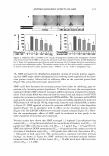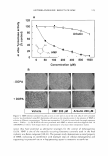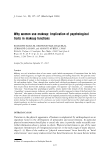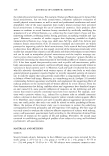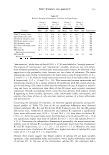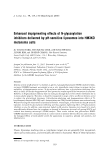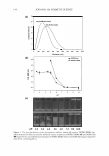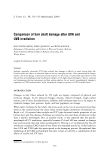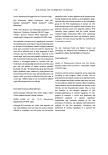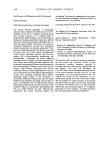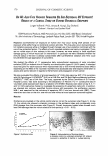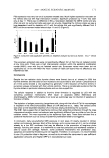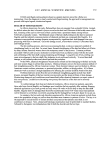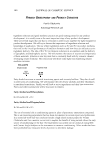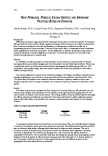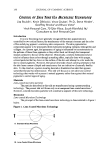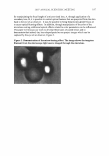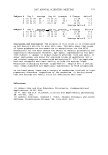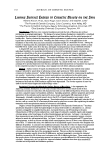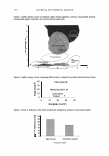130 JOURNAL OF COSMETIC SCIENCE using principal component analysis (PCA) and analysis of variance (ANOVA). Statistical significance was set to a maximum risk, a = 0.05. RESULTS CLASSIFICATION OF SUBJECTS FROM SELF-ASSESSMENT QUESTIONNAIRES In our study, data from Liken scales have been reduced to a nominal level by combining all responses into two categories of "agree" and "disagree." The significant percentage of agreement for specific sentences is described in Table I. The results show two large and distinctive groups of volunteers. The first (class A) regroups 21 female subjects (mean age 47 years ± 12), while the other (class B) is composed of 49 female subjects (mean age 43 years ± 10). The responses of the female subjects in class A refer globally to negative self-assessment or withdrawal from others (Table I). For example, these subjects typically fully agree with propositions such as: "Without makeup, I don't like myself' (62%) or "I always make myself up when I am in contact with people" (95%). On the other hand, the responses of class B subjects refer to a positive self-assessment or approach to others (Table I). For example, these subjects typically fully agree with such propositions as: "I make myself up in a more intensive way in the evening" (92%) or "When I'm made-up, I feel sensual" (76%). Overall, the pattern of responses of class A subjects regarding makeup use can be considered as a "camouflage" profile (i.e., aiming Table I Analysis of the Makeup Questionnaire (n = 70) Sentences When I'm made-up, I feel glamourous With makeup, I want to smile I always make myself up when I am in contact with people When I'm made-up, I feel natural When I'm made-up naturally, I feel myself I'm not afraid to change my makeup process to remain faithful to myself I make myself up in a more intensive way in the evening A woman who does not make herself up, it is a pity In the evening, I make myself up to allure Without makeup, I'm insipid A woman who does not make herself up is a woman who overrates intellectual dimension to the detriment of appearance I use makeup to control the image of myself When I'm made-up, I want to allure I don't like my face without makeup Without makeup, I don't like myself When I'm made-up, I feel sensual Percentage of agreement for specific sentences Class A Class B (n = 21) (n = 49) 25A 63B 14A 47B 95B 61A 43A 33A 81 A 86A 71B 20A 57A 92B 76B 47A 48A 67A 76A 55A 24A 10A 48A 59A 3 8A 69B 76B 47A 62B 33A 43A 76B Significance S (p 0.01) S (p = 0.02) S (p 0.01) NS NS S (p 0.01) S (p 0.01) S (p = 0.05) NS NS NS NS S (p = 0.0 3 ) S (p = 0.05) S (p = 0.04) S (p = 0.02) When there is a significant difference between classes, we indicate by letters (A, B) the class to which it belongs. If the classes have the same letter, they are comparable if not, they are significantly different.
WHY WOMEN USE MAKEUP 131 at decreasing the load of their negatively perceived attractiveness and/or global self- image), while those of class B subjects refer rather to a "seduction" functional profile (i.e., aiming at supporting and promoting a positive self-image). If we analyze more precisely these two classes, we observe a statistically significant division of the "seduc- tion" class (i.e., class B) into three different subclasses (Table II), depending on the relative valuation of the natural and made-up face of each subject. The same analysis for class A did not reveal sustainable subclasses. In the first subclass (subclass B 1) of class B, the made-up face is considered to be more valuable than the natural face and less variability is introduced in the makeup structure. For example, these subjects claim "Without makeup, I'm insipid" (81 %), "I don't like my face without makeup" (69%), or "When I'm made-up naturally, I feel myself' (100%). For the third subclass (subclass B3) and in comparison to subclass Bl, the "natural" face is rather perceived as more valuable than the made-up face. For instance, these subjects typically agree with "I use makeup to control the image of myself" (30%) or "In the evening, I make myself up to allure" (100%). Concerning the intermediate subclass (subclass B2), "natural" and "made-up" faces are considered as valuable as each other relative to the subject's personal and professional life. For example, women of this subclass claim "I always make myself up when I am in contact with people" (70%), Table II Analysis of the Makeup Questionnaire for Class B (n = 4 9) Sentences When I'm made-up, I feel glamourous With makeup, I want to smile I always make myself up when I am in contact with people When I'm made-up, I feel natural When I'm made-up naturally, I feel myself I'm not afraid to change my makeup process to remain faithful to myself I make myself up in a more intensive way in the evening A woman who does not make herself up, it is a pity In the evening, I make myself up to allure Without makeup, I'm insipid A woman who does not make herself up is a woman who overrates intellectual dimension to the detriment of appearance I use makeup to control the image of myself When I'm made-up, I want to allure I don't like my face without makeup Without makeup, I don't like myself When I'm made-up, I feel sensual Percentage of agreement for specific sentences Subclass Bl Subclass B2 Subclass B3 (n = 16) (n = 23) (n = 10) 5 6B 61B SOB 44AB 44AB 6QB 5 6A 7QAB soA 6A 4 SB 4 QAB lQQB S7AB 60A 13A 26A 20A SSAB 91B lOOB 5 6AB 3 5A 60AB 44A 7QAB lOOB SlB 39A soAB QA 4A 4 0AB 75B 61AB 30A 75B 61AB SOB 69B 35A 4 0AB SOB 17A 4 0AB 69AB 7 4AB 90B Significance S (p = 0.0 4 ) NS S (p = 0.03) S (p = 0.0 4 ) S (p = 0.0 5 ) S (p 0.01) S (p 0.01) NS S (p = 0.01) S (p = 0.03) S (p = 0.01) NS NS S (p = 0.0 4 ) S (p = 0.0 4 ) S (p = 0.01) When there is a significant difference among classes, we indicate by letters (A, B) the class to which it belongs. If the classes have the same letter, they are comparable if not, they are significantly different.
Purchased for the exclusive use of nofirst nolast (unknown) From: SCC Media Library & Resource Center (library.scconline.org)

















